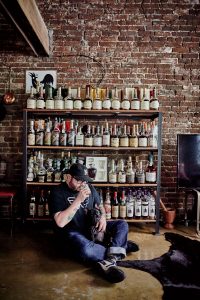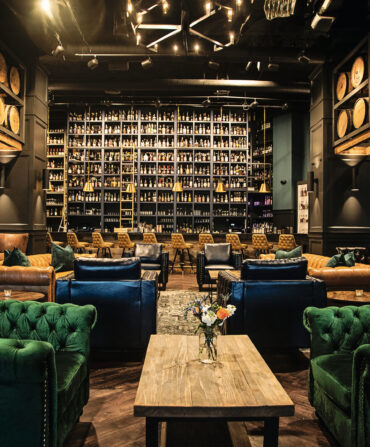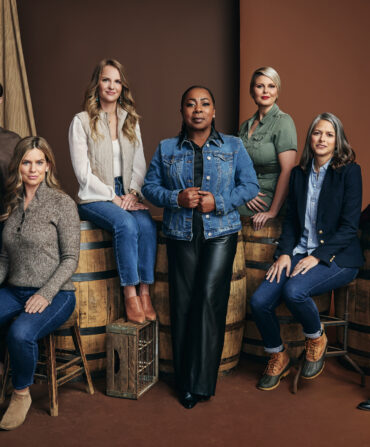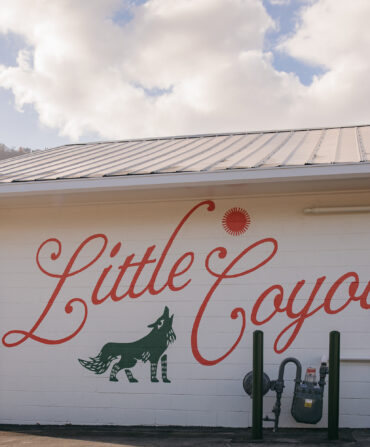Drinks
The Great Bourbon Taste Test
What happens when a dozen-odd whiskey aficionados, led by one maniacally obsessed Southern chef and the reigning bourbon king, gather to test twenty-four years’ worth of a legendary brand? Among other things, a hell of a good time

Photo: Peter Frank Edwards
“I’m not sure we’ve got enough bourbon,” said the chef Sean Brock on the morning of the epic whiskey tasting. Brock was joking. The quantity of bourbon in the room had turned the daylight brown.
Bourbon was not only the dominant decor in Brock’s downtown Nashville loft; it was, by volume, the primary occupant. Crowding Brock’s living room were geriatric gallons of Old Grand-Dad and Old Fitzgerald, enthroned on their own miniature rocking chairs. Imp-scale bottles peeped out from behind cured hams (another form of furniture here). Against the near wall stood a four-shelf bookcase stacked three deep with bottles that would make a bourbon fancier take out a second mortgage. Shelved there were delicious antiques including but not limited to Old Rip Van Winkle, David Nicholson 1843, and Very Very Old Fitzgerald, which Brock sells at his acclaimed restaurant Husk for $240 per pour.
The business at hand, however, was not Brock’s deep holdings but a lately acquired army of fifths, pints, and handles crowding the kitchen island. With the help of his girlfriend, Adi Noe, Brock—known for his Charleston, South Carolina, restaurants McCrady’s, Minero, and also Husk, whose Nashville branch opened in 2013—was draining the bottles into anonymously numbered flasks for the day’s blind tasting.
The collection represented a twenty-four-year “vertical” of W. L. Weller Special Reserve containing a bottle from every year from 1987 to 2010. Vintage Weller is a substance direly coveted by bourbon fanatics. It is a close sibling of Pappy Van Winkle, a bourbon over which the whiskey world has lately gone insane. Empty bottles of Pappy can sell on eBay for upwards of a hundred dollars. A full bottle, when it can be found, will set you back thousands. The good news is that modern-day Weller is a lot easier to find than Pappy, and it is genetically identical to the celebrated stuff. Weller and Pappy enter the world in the same distillation. As they age, the most extraordinary barrels get set aside for the Van Winkle line. The unchosen ones are sent off to market under the Weller label at a bit north of twenty dollars a bottle, within reach of the common man.
In Chef Brock’s unguarded opinion, vintage Weller is “the best damn whiskey ever made in the whole world. You taste it and you have to have it, no matter the cost. Then you become obsessed with different labels and expressions and years, and then you wake up one day and you have way too much whiskey in your apartment.”
The loosely scientific purpose of today’s gathering was to determine which bottlings and distilleries have produced the tastiest Weller. This advance in whiskey knowledge, Brock explained, had come at considerable inconvenience and strain. “This will only happen once,” he said, topping off a taster’s flask. “It’s a pain in the ass and it’s expensive as hell.”
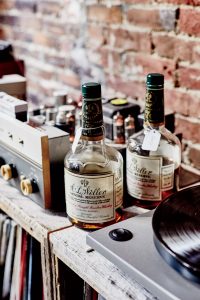
Photo: Peter Frank Edwards
A couple bottles of W.L. Weller Special Reserve stand ready for tasting.
Assembling the twenty-four Wellers took him the better part of a year and the better part of ten thousand dollars. So where did he find all of these obscure bottlings? I asked Brock. He looked at me as though I’d demanded power of attorney. “It’s a secret,” replied the chef, a solid, low-built man of thirty-seven with plentiful tattoos. “If I tell you where I bought it, then you’ll go buy it all, and then I’ll kick your ass, and then we’re not friends anymore.”
Sampling all twenty-four bottles would be a full day’s work running from noon to night in two shifts with a lunch break in between. Right around twelve o’clock Brock’s team of connoisseurs arrived. There were twelve or so of them, I think (soon into the tasting, they became hard to count). Mostly from out of state, they were a disparate bunch of middle-aged men who had intersected over the Internet at a common node of bourbon obsession. There was Mike, a guy from Pennsylvania who, in addition to ransacking “dusties” from the storerooms of rural liquor stores, worked for a water quality bureau and also collected jeeps. There was a hulking man named Jared, the whiskey curator of the Washington, D.C., bar Jack Rose. Rampant peptic ulcers had forced Jared onto the wagon, but his commitment to bourbon was so intense that he had traveled more than five hundred miles merely to smell the Wellers. There were guys who worked in restaurants and residential construction and a guy who claimed to be the campus chaplain at a university in Florida. Beyond maleness, their only ostensible common thread was a nearly hazardous degree of whiskey expertise. To get into conversation with these fellows was to become a receptacle for information about tax stamps, the history of sour mash, Distilled Spirits Plants codes, and the chemistry of barrel char.
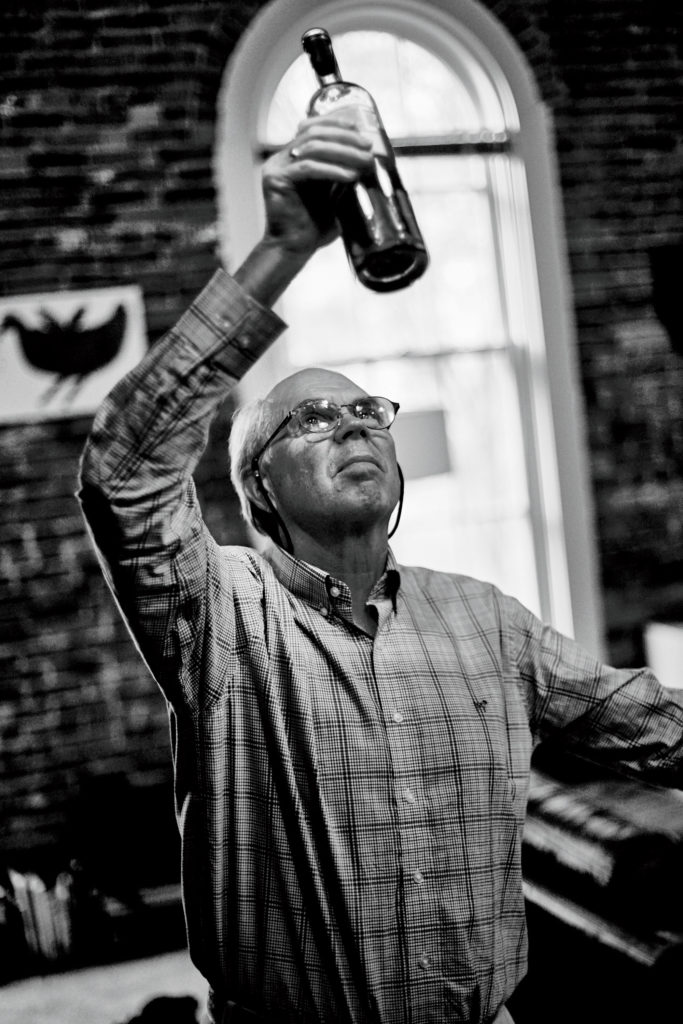
Photo: Peter Frank Edwards
Julian Van Winkle III studies a bottle.
Elevating the gathering from an assembly of serious bourbon hobbyists to a conclave of the royal whiskey society was the arrival of Julian Van Winkle III and his son Preston. Julian III is the president of the Old Rip Van Winkle company. He is the grandson of Julian “Pappy” Van Winkle, Sr., the late co-owner of the Stitzel-Weller Distillery, which sits at the headwaters of the Weller/Van Winkle bourbon streams. It was Julian III who first bottled the Pappy Van Winkle line of whiskeys and who also made a bourbon extremist out of Sean Brock.
“I wasn’t a bourbon fanatic until I drank Pappy Van Winkle, which wasn’t until 2007,” Brock recalled. At that point, he had been confining his culinary relentlessness to the meticulous sourcing of heritage rice strains, cowpeas, grits, and Ossabaw Island hogs. In 2008, Van Winkle collaborated with Brock on a Pappy Van Winkle dinner at McCrady’s. After that, Brock fell into an obsession whose ferocity outstripped Van Winkle’s own.
“Damn,” said Van Winkle, taking in Brock’s bourbon rack. “And I thought I had it bad.” Then Van Winkle turned toward Brock, and in a coals-to-Newcastle gesture, presented the chef with a bottle of twelve-year-old Weller. “What do you want for it?” Brock asked.

Photo: Peter Frank Edwards
Testing a vintage W.L. Weller.
“I don’t know,” said Van Winkle, musing. “Let me drink good whiskey all day, I guess.”
By now, the connoisseurs were getting restless. They were up on their toes. They were ready to drink. A visiting journalist, however, was feeling pangs of concern. While the rudiments of bourbon drinking are not lost on me, twenty-four was more glasses of whiskey than I usually have in one go. Grateful though I was to be along for this once-in-a-lifetime binge, I did wonder how much of the vertical I would manage to blind-taste while remaining vertical with sight left in my eyes. The temptation was strong to batten down, to put leashes on my wallet, phone, and keys, to pin to my lapel the address of my hotel. Still, this was anxious expectancy of a pleasurable kind, like anticipating the onset of a sumptuous typhoon.
But in his wisdom Chef Brock had laid in a hospitable array of sobriety preservers: a fleet of deviled eggs, pimento cheese and crackers, ham biscuits with pickled cauliflower, and a saw-your-own hog leg over by the bourbon shelf, a saber jutting from the meat.
There was no spittoon in sight.
“Dig in, boys,” Van Winkle said, and so it began. The tasters’ sheets were handed out. The men approached the bottles and tipped brave quantities into Glencairn glasses. Each man then stole off to a chair or a corner to get into a communion with his portion. Moans were general.
Van Winkle sat on a pile of cookbooks (in Brock’s apartment whiskey fills the bookshelves; books go on the floor) and put his nose into his glass. “This is from back in the day. A little oxidized,” he said, when pressed for a description. “Not much oak, huge vanilla. Funky, basementy.” He took a sip, tested his palate, and awaited the arrival of adjectives that did not come. “Aw, hell, I’m the worst whiskey writer. I like it or I don’t. This, I like.”
“Oh, my God,” Chef Brock was saying to his glass. “That is so good. That’s it right there. That’s Stitzel-Weller. I’d know it anywhere.”
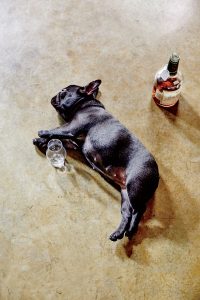
Photo: Peter Frank Edwards
Brock’s French bulldog, Ruby, takes a snooze.
Without straying too far down connoisseurial rabbit holes, it must be noted that within the general mania for Weller bourbons is the submania for the Stitzel-Weller vintages that has claimed Sean Brock. Opened in Shively, Kentucky, outside Louisville, in 1935, the Stitzel-Weller Distillery churned out W. L. Weller, Old Fitzgerald, Old Cabin Still, and Rebel Yell until 1992, when the business shut down. The W. L. Weller label was then sold to the Bernheim Distillery and resold, in 1999, to the Sazerac Company, whose Buffalo Trace operation produces the Weller and Van Winkle bourbons today. The general consensus in Brock’s living room was that Buffalo Trace Wellers are unlikely to recover the glory of the Stitzel-Weller years. Though the mash bill remains the same (using sweeter wheat instead of spicy rye), distilling is an occult business, dependent on the idiosyncrasies of the oak in the barrels, the method of grain milling, the distiller himself, and the thermal felicities of the warehouse where the whiskey is aged.
Stitzel-Weller bourbons, Brock said, still sniffing his sample, could be identified by aromas of maple, butterscotch, basements, and other quiddities that are hard to pin down. “You know when you’re in the room with your girlfriend or your wife and you know her smell, her perfume? Stitzel-Weller’s like that for me. I’ll be surprised if I miss any. It’s all I drink.”
But what if, God forbid, Brock should find himself far from home at cocktail hour, with no Stitzel-Weller in reach? Which commonly available label would he resort to in a pinch? “Easy: none. It doesn’t exist” was his discouraging reply.
By two o’clock, having sampled and rated the first twelve whiskeys, the connoisseurs gathered around the kitchen island to announce their findings. Most eyelids in the room were sagging redly at half mast, but no one yet had fallen down or begun to speak in tongues. As far as the connoisseurship went, green apples, cooked apples, cellars, peanuts, damp periodicals, cardboard, cough drops, Goo Goo Clusters, cocoa, and maple were the notes most commonly cited. After each bottle was commented upon, Adi Noe (who was abstaining and still perfectly literate) would read its vintage from her code sheet, confirming a glum fact: Tasted blind, the bygone Stitzel-Weller bourbons rated the highest.
Nevertheless, Chef Brock was happy. Brock was exuberant. “Who wants to have a push-up contest?” was a question he put before the group. This challenge went unanswered. “All right, all right, who wants to go eat lunch at the greatest restaurant in the entire goddamn world?” At this invitation, the group, in serious need of solid food, perked up.
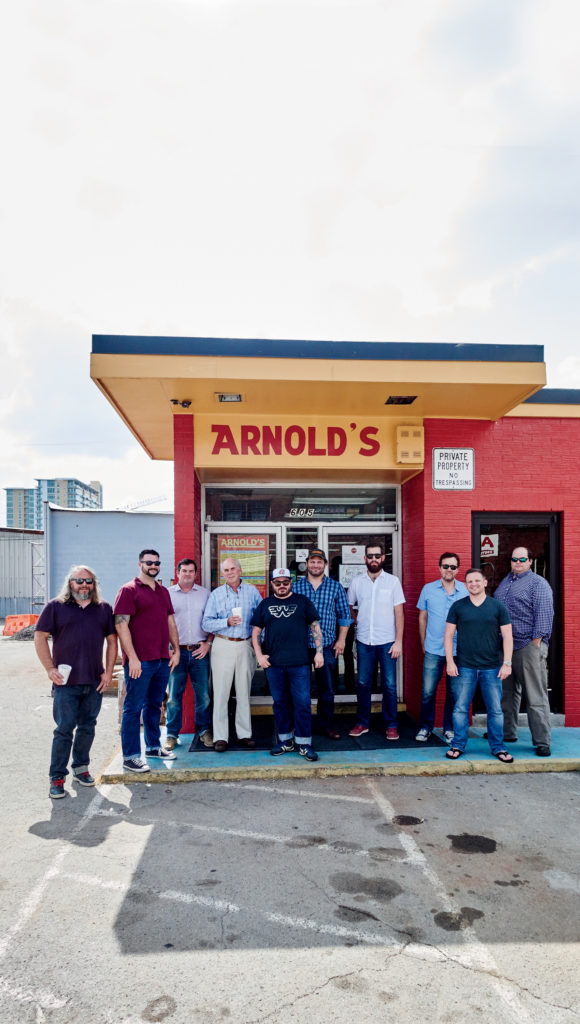
Photo: Peter Frank Edwards
Soaking Up The Whiskey
The tasting team takes a break for lunch at Arnold’s Country Kitchen.
The greatest restaurant in the world was a place called Arnold’s Country Kitchen, a cafeteria-style Southern joint between the Nashville neighborhoods of Pie Town and the Gulch. Arnold’s standard bill of fare is a meat and three. But the manager on duty was a sympathetic friend of Chef Brock’s, and she had her own prescription for our group’s condition. “Just give ’em everything,” she told the servers at the steam tables. After a solid ballasting of roast beef, chicken, fried catfish, succotash, potatoes, green beans, stewed okra, black-eyed peas, turnip greens, baked squash, mac and cheese, and peach and chocolate pies, we were once again prepared to look a glass of whiskey in the eye.
Back at Brock’s apartment, the restorative feed notwithstanding, tasting the next twelve bottles of the best goddamn whiskey ever made in the whole world began to feel like work. Jotting taster’s comments became not quite possible. The bourbon began to seem like an attractive but querulous girlfriend demanding confessions of “feelings” one was unable to articulate. Reports of failing faculties came in from around the room.
“I can’t feel my legs,” said a guy named Quintin. “Is that a good thing?”
“I don’t know where I am, but I’m having fun,” said Mike.
The effects of our researches had ripened to a point where a rash of fistfights, weeping fits, or embraces seemed both possible and imminent. “Hey, do you know karate?” Brock asked me in a tone that did not put me at my ease.
Across the room, Beau, a builder from New Orleans, was leaning into the personal space of Julian Van Winkle III. “Julian, we are brothers from another mother,” he informed the bourbon king.
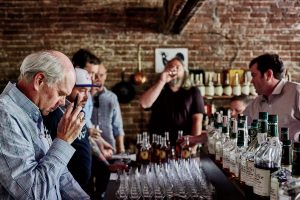
Photo: Peter Frank Edwards
Van Winkle takes a deep whiff.
“As long as you don’t ask me for a bottle of whiskey, I’m your buddy,” said Van Winkle, turning toward a tabletop teeming with unsampled bottles. “Man,” he said wearily, “a cold beer would be good right about now.”
Close to 5:00 p.m., with the light fading in the windows, Brock roved the room like the coxswain on a rowing galley, urging the exhausted tasters to press on. “Hey, come on, let’s finish this thing so we can go ahead and get f**ked up.” (By the chef’s standards, apparently, there was still work to be done on that score.)
In due course, the tasters’ congress got to its feet and congregated, bespattered tasting sheets in hand. Opinions were ventured, profanely contested, and sheepishly disavowed. Over the course of twenty-four whiskeys, the differences between Stitzel-Weller, Bernheim, and Buffalo Trace bourbons had grown markedly less profound. Vintages and distilleries were wildly misguessed, which wounded the aficionados’ pride. Round two of the tasting was pronounced “a disaster,” “a crapshoot,” and “amateur hour.” Nevertheless, Brock carried everybody’s tasting sheet off to a back room, where something statistical was going to happen. “Well, the important thing,” said Mike, pouring a fresh glass, “is at least everybody got drunk.”

Photo: Peter Frank Edwards
Sean Brock in rare form.
Though not to the point of calling it quits. With the program of scientific drinking concluded, the connoisseurs were now at liberty to drink whiskey for fun. Brock’s shelves of priceless bourbons were set upon. A 1949 Old Fitzgerald in a gold brocaded bottle got passed around. Someone broke the seal on a ’41. Julian Van Winkle III was seen slugging Very Very Old Fitz straight from the bottle. This phase of the spree was both thrilling and worrisome. It was like watching a greenhouse of priceless orchids under siege by discerning but hungry goats.
Fortunately for Brock’s collection, by nine o’clock everyone had drunk as much bourbon as he cared to. The idea of stepping out for a cold beer was proposed to unanimous approval. Out into the Nashville night we lumbered. Music came from the saloons. The bouncer at Robert’s Western World saw fit to take us in. On the stage a grimacing guitarist rolfed a Telecaster to wring from it that drunken Nashville sound. Some cunning, generous member of our group figured out where the bar was. And just in the nick of time, we were each of us handed a coldly perspiring can of Pabst Blue Ribbon, which we drank like the water of life.


